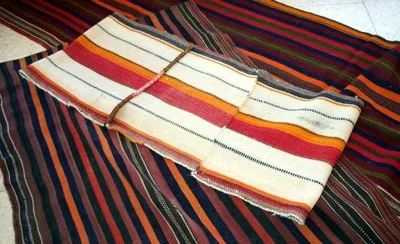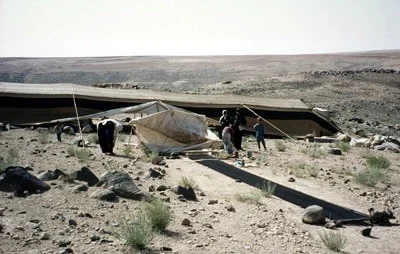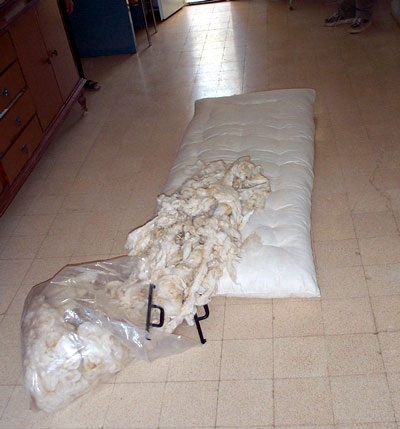Weaving Rugs
Donkey bag
The women of Simakiyya no longer engage in the handicraft of weaving but the Bedouin living around the village are still very actively involved in the whole weaving process. For thousands of years women have followed the same process of weaving. Their weaving has resulted in rugs for the floor, rugs to cover the mattress type pads in the sitting area of the tent, cushion covers, bags for storing grain and clothes, saddle bags for camels and donkeys, and cradles to carry their children on their backs.
For the villagers, commercial products have supplanted woven handicraft items yet most villagers have a number of rugs in storage that either they have woven themselves or are heirlooms from the mothers and grandmothers. When cash is needed, these heirloom rugs are sold to tourists that happen to be passing through the village or to outside vendors. These occasional sales are depleting the rug supply and these family treasures are quickly disappearing.
Some folks in Simakiyya are very concerned about this traditional craft disappearing and are seeking a way for the older women who know the craft to teach the younger women in the village how to weave. One of those concerned is Father Boulos of the Roman Catholic Church who would very much like to see a weaving center established where training and production could take place. At the present time, there is no money for such a project and if production did occur, the market for such production is uncertain. Weaving centers have been set up in a few villages and the Bani Hamida Project is one of several very successful village weaving projects established in Jordan.
Rugs that are family heirlooms
In the city of Karak, there are several weaving shops where Egyptian weavers on upright looms produce the tradition Jordanian rugs and saddlebags for the tourists. The rugs contain commercial yarns and are usually loosely woven; consequently, the rugs do not last very long. Father Boulos would like to see the craft reappear in Simakiyya and the income generating activity help the financial woes of the village women. The village weaving center could produce rugs that are much more substantial and women could weave rugs with their traditional tribal patterns. Village weaving would be an art form and not just a profit-making enterprise as it is in the city.
Bedouin tent and weaving in process
Bedouin living around the village still weave the long narrow rugs that when sewn together form the outside wall and top of the tent. A tent is called bait esh-sha'ar, or literally "house of hair". In late fall when the harvest is in and before the rainy season, the Bedouin women set up their looms and start the process of weaving. A long rug one meter wide and four meters long will take the women more than two months to complete with several female family members working together. Weaving is very much a social activity with groups of women chatting, drinking tea and working on the rug.
Wool for making mattresses
Weaving is only the final stage in a long process of production. For both the villagers and the nomads, shearing of the sheep and goats takes place in the spring after the animals have been washed. The villagers sell most of their sheep wool but some is kept as filling for their mattresses used for sitting and sleeping. On the other hand, the Bedouin have a lot of goats and use the coarse hair from their goats for weaving the thick tent rugs. One can see the Bedouin women walking through the village with their meghzal, or spindle, as they conduct their business while spinning the yarn for their rugs. The spindle is constructed of a wooden staff on top of which is a small moveable wheel with a hook that holds the spun yarn as it is wrapped around the shaft.
Bedouin women and ground loom
Weaving done by the Bedouin women living near the village is done on a ground loom. The loom is constructed of very simple materials of sturdy sticks and stones. Two wooden sticks are pinned to the ground and the woolen yarn stretch between them while another stick is placed in the middle to separate the long warp threads. The woman sits cross-legged at the end of the ground loom and feeds the weft yarn attached to a stick back and forth between the twisted threads. The weaver gradually moves down the length of the rug and maintains the tightness of the threads. Dark colors are preferred. The traditional colors include deep reds, navy blues, greens, oranges and black.
Several useful sources on weaving are available. One I would recommend is The Crafts of Jordan: An Introductory Guide, by Meg Abu Hamdan (Amman, Jordan: Al Kutba Publishers, 1989). Also, a portion of a report to the Ministry of Agriculture written by Dr. Raid Al-Baqain can be seen here.




